Thanks, Mom
An appreciation for my mother, in spite of the fact she almost turned me off from running
In this week’s post, I turn inward to reflect on my family and the past, including a story about my first impression of running and women runners. Stay tuned next week for a conversation with one of the sport’s most interesting top-level runners in Colorado, who at 40 has entered a new phase in her relationship with running and competing. Please sign up for a free or paid subscription if you haven’t already. Our monthly online meetup for paid subscribers takes place this Sunday afternoon.
I’m recovering from an emotional week during which my siblings and I held a memorial service for our mother, and I hosted several sibs, nieces, and a nephew at our home. So much focus on an event, and so much celebration mixed with mourning, left me feeling deflated after everyone departed.
I ate heavy comfort food while they visited, including remakes of two of Mom’s kid-friendly recipes: “kids’ cass” (a casserole of mac and cheese topped by seasoned ground beef) and “chicken olé” (a cheesy dish layered with tortillas and the retro ingredient of Campbell’s Cream of Mushroom soup). I drank more than usual—beer, mostly, but also we toasted Mom with rosé wine diluted with ice cubes, her favorite. We laughed and cried during a trivia game we made up with dozens of questions related to Mom’s life, vying for the macabre prize of a reusable shopping bag from the funeral home that carried her ashes in an urn.
My brother wondered aloud, why do we wait until someone dies to gather like this? Our mom and dad (who died in 2013) would have loved it. We had not gathered like this in nine years, since Dad died.
I’m sharing some personal stories this week not only to honor my mother, Val Lavender, but to consider the legacy she and Dad passed down. Also, preparing a eulogy for her service made me ponder storytelling and how we choose to remember people and events.
For most of my adulthood, I viewed my mother and my childhood critically, parenting my own kids differently in reaction to what I viewed as her irresponsible and antifeminist ways. As she declined, however, I began to view her more empathetically. She worked her ass off as a homemaker and part-time librarian, then shopkeeper, and maintained an optimistic outlook while being wife to my temperamental, gregarious, heavy-drinking dad and raising all of us. She gave so much of herself to her husband and kids.
I am who I am and where I am thanks to my parents. I am “the baby” and “the afterthought,” the youngest of five, with a seven-year gap between myself and sibling #4. I’m a Coloradan and Californian because my parents straddled both states, spending summers in Telluride and the school year in Ojai.
My mother was more housewife-y than outdoorsy, and yet, a great deal of my life today mirrors hers. I start the morning reading a mainstream novel, not highbrow literature, just like she did. I organize by excessively making lists, as she did. I plant flowers in front of our house because Mom cultivated flowers wherever she lived. In our Telluride cabin that Dad built in the early 1970s—located right across the road from my current home—Mom always had fresh columbine, paintbrush, daisies, and a wildflower nicknamed “eggs and butter” in a vase.
When I camp these days, I marvel at how Mom managed family life while we camped for extended periods when I was a little kid. She prepped dinners in the dirt, squatting at a campfire. She packed elaborate picnics, my favorite being marinated steak kebobs to grill in the woods.
On the rare occasions I go out to a bar, I eagerly challenge others to play pool because I grew up shooting pool with Mom and Dad on the cabin’s pool table. I don’t like to fish, but if I had to, I could catch and gut a fish, roll it in cornmeal, and fry it because Mom and Dad caught and fried trout for breakfast. I keep my house extra tidy because I can’t help it—Mom raised me to pick up after myself and others.
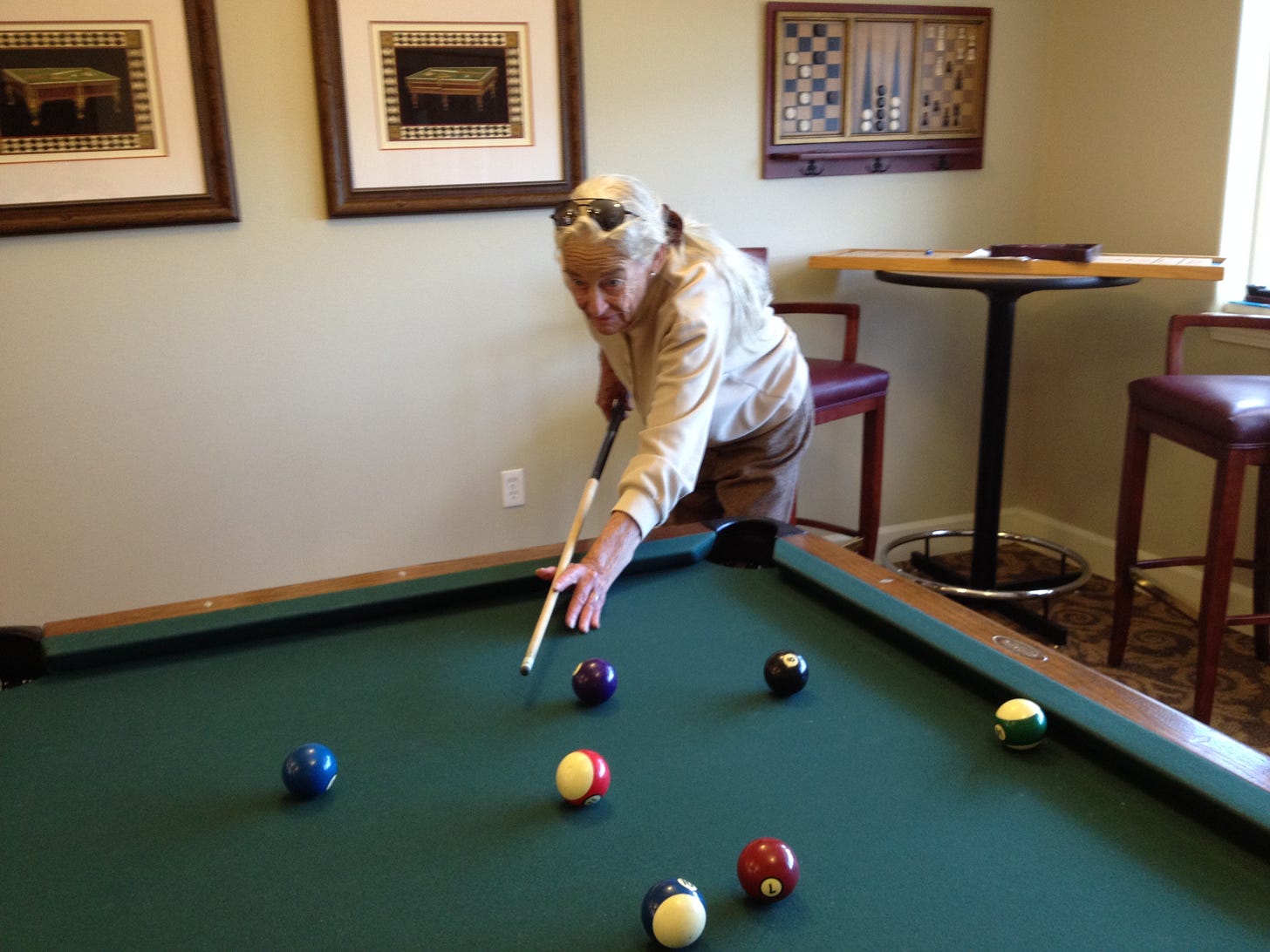
Mostly, I have a sense of place and of belonging—belonging in these mountains and being part of a loving large family—perhaps the greatest legacy our parents gave us. They introduced my siblings and me to these mountains when we were kids, during hikes and long day trips in Dad’s 4WD truck over old mining roads.
I thought about this legacy and sense of belonging—and how I carve my own path—last Sunday as I crested a ridge line over 13,000 feet above Telluride. As I gazed at the mountains that form the box canyon, my heart felt swollen from high-altitude exertion combined with emotion, the strongest feeling being gratitude that my parents raised me here. I missed them intensely. As I summited a peak with a friend, I looked northeast to Imogene Pass, where I would meet up with my sibs and husband, who were driving over the pass in a Jeep. I ached with longing to see Dad and Mom driving in the cab of their truck.
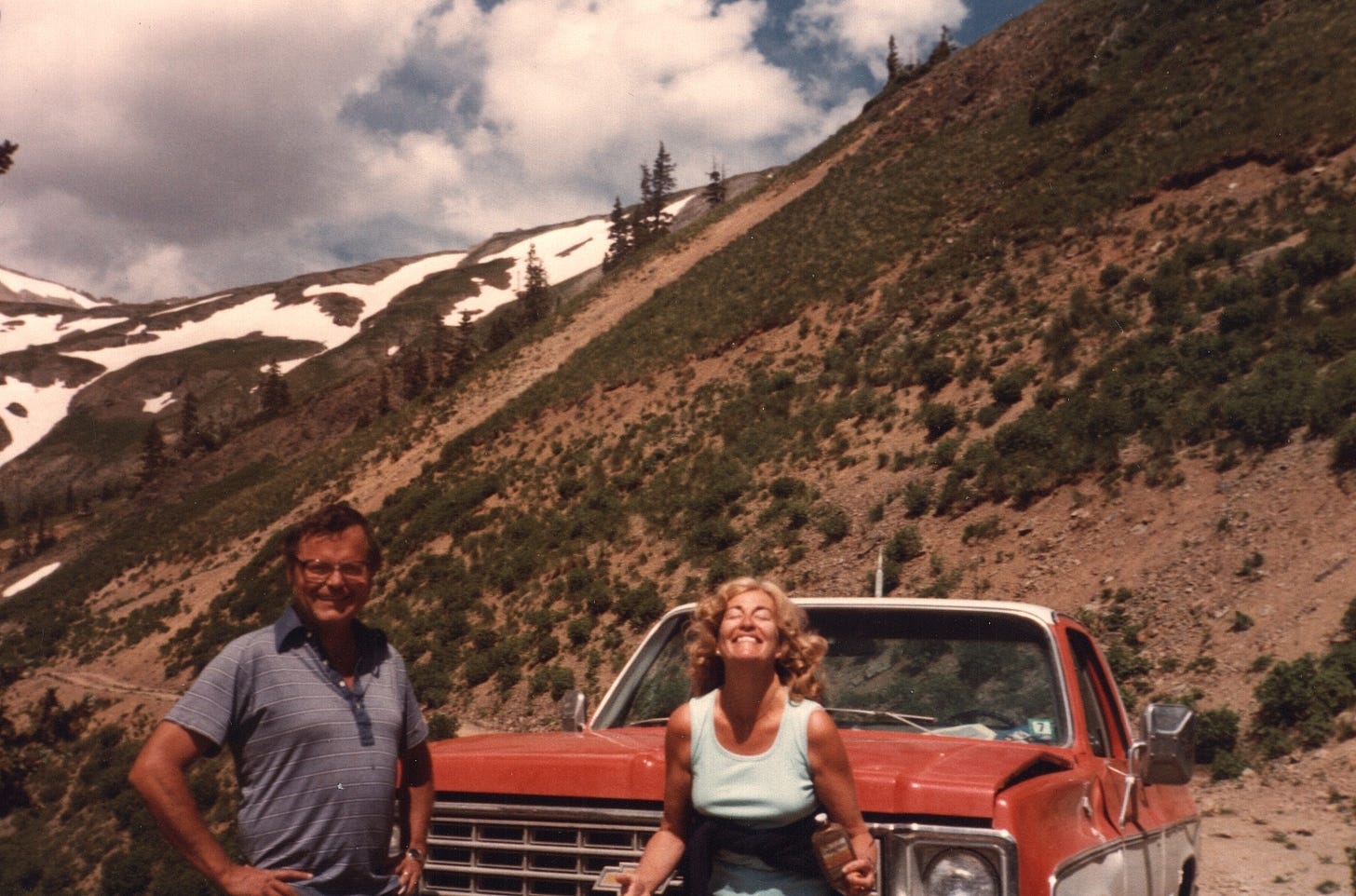
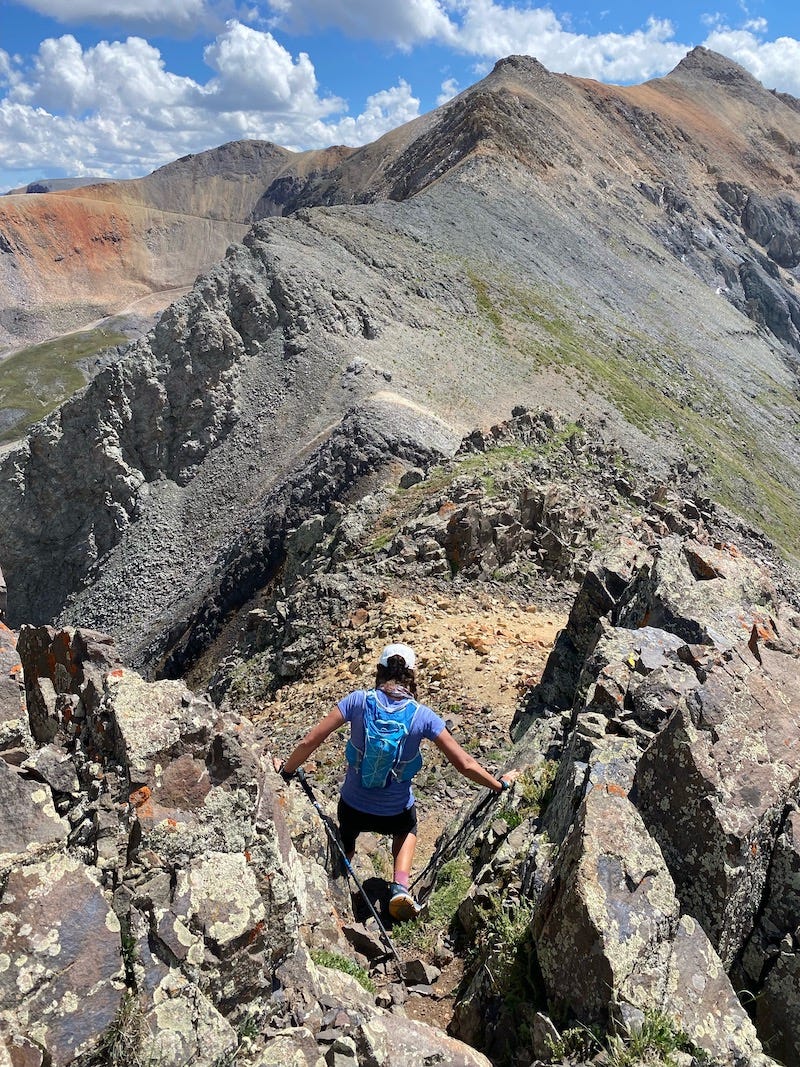
I could have driven with my siblings, but I wanted to get to Imogene on my two legs. My passion to run and train for races is driven in part by wanting to defy aging and avoid my parents’ health decline. When they were my age, they already showed the effects of lifelong cigarette smoking. My dad died of lung failure at 78. Sensing mortality from my parents’ passing, along with the death of my husband’s younger brother from cancer, has made me acutely concerned with health.
I’m also inspired and driven by the legacy of my dad’s parents. It’s because of dad’s dad we’re here, since he was born and raised in Telluride. Grandpa, his wife, and his brother all thrived in the San Juan Mountains in the 1920s and early ‘30s. Yet only Grandpa survived into old age. My grandmother—the first woman on record to summit the 14er Sneffels, who helped Grandpa handle all the chores of running a cattle ranch—died at 49 from an aneurysm. Grandpa’s brother Dwight, lauded as one of the most accomplished pioneering mountain climbers of his generation, died suddenly of polio at only 23. Could I die unexpectedly young like that? Yes, we all could. So I live life with a heightened appreciation that it’s fleeting.
Mom declined with dementia after Dad’s passing, but her body held out. Dementia, as terrible as it is, gave two unexpected gifts. It made her quit smoking—she wasn’t allowed to smoke in assisted living, and eventually she forgot about her craving for a cig—and it made her highly mindful and childlike, living in the present moment. She was more cheerful than depressed.
I treasured visiting her, even on weeks when it felt obligatory and her ability to make conversation degenerated into short, garbled phrases. Toward the end, she had only a vague understanding of who I was, but I know my visits made her feel better. She expressed herself with a raised eyebrow and a smile that showed all her missing teeth. I filled the gaps in conversation by telling her about my life and showing photos on my phone that made her laugh.
I grew physically closer to her, expressing care by massaging her shoulders and rubbing lotion on her flaky, easily bruised skin. I didn’t mind helping her go to the bathroom. Her purple swollen feet did not gross me out as they might have earlier in life; I wanted to prop them up and rub them.
If only I had made time and effort to have these conversations and be closer with her on a more regular basis when I was younger. She tried, through letter writing and phone calls, to stay in touch with me when I was a young adult raising my kids. But, I admit, I mostly blew her off and took her for granted, because I felt so judgmental about her parenting style and the role model she had been to me. It wasn’t until Dad died and I moved to Colorado that our relationship entered this new phase, the mother-child roles reversed.
Back in 2016, when I was a columnist for Trail Runner magazine, I wrote the following short essay about Mom. I wince to read it now for its unflattering portrayal. But I’m sharing it here because it details my first impression of running, and it shaped my view of being a woman. And, toward the end, I see a seed of empathy for her—trying to understand her perspective—that blossomed in more recent years. My eulogy last Friday shared other stories from childhood, and I told our gathering that when I re-examine childhood memories, I feel I should have cut Mom slack and given her more credit.
When I re-read the story below, I try to set aside the fact I grew up in smoke-filled cars and took up smoking at 16. (Mom, in her misguided but generous way, would let me charge cartons of Camel Lites to her account at the pharmacy.) I try instead to zoom in on the fact I was so lucky to grow up on the east end of the Ojai Valley with a horse, thanks to Dad’s job at a school there that had a horse program, and the fact Mom drove me back and forth to the stables innumerable times. I also choose to remember the happy times we had together at my elementary school’s library, where she worked as a librarian and enlisted me as her special helper. And I imagine the “what if,” if she had put on shorts and tennies and jogged around the block like the woman in the story below.
This is how I first viewed running, thanks to Mom.
You’ve Run a Long Way, Baby
Every time we drove by Pat, my mother said something negative. Sometimes it was a simple, “Humph!” with a shake of her head, but usually her remarks made me study Pat closely, as if on a safari spying a native.
“Look at her skin,” she’d say. Or, “Look at her legs.”
Pat’s slightly wrinkled skin looked deeply tanned, and her bare legs looked muscly. She reminded me of my hero Jaime Sommers from “The Bionic Woman.”
My mother, then 44, would be driving our brown Datsun. She teased the front of her ash-blond hair into a bouffant and wore a pink Izod Lacoste and pink lipstick. A Benson & Hedges rested on the steering wheel between her fingers, filling the car with smoke.
Pat, younger than Mom by nearly a decade, ran all around the East End of the Ojai Valley in California, every day, and we’d spot her when Mom drove me up the road to feed my horse.
Pat always gave me a wave and a smile, and always looked the same: legs striding in Dolfin shorts, arms swinging from a cotton shirt, armpits and face dripping sweat. She permed her hair like Barbra Streisand and clutched a navy blue bandana in one fist to wipe her brow.
“No wonder her kids show up with their hair not combed,” said Mom, who worked part time in the school library. (She said this in spite of sending me to fourth-grade Picture Day with day-old frizzy braids and a large mustard stain on the bib of my OshKosh overalls.)
One morning Mom sneered, “Look at her tits.” So I looked, and I saw golf-ball-sized breasts moving with Pat’s rhythmic steps. Having heard Dad remark on other women’s “nice tits,” I guessed that Pat’s were not nice.
Pat was my only connection to the running boom, circa 1978. In elementary school, I performed poorly in the Presidential Physical Fitness Test, and, in junior high, I hated running the required two laps in PE.
When I was in ninth grade, Mom gave me the 1982 bestseller Thin Thighs in 30 Days—a gift that made me aware of my thigh size as never before—and I took to heart the book’s advice that running isn’t necessary and could be harmful. The book extolled, “Work-Off, Walk-Off, Weight-Off!”
Only later could I begin to understand how a strong, earthy “women’s libber” (as Dad referred to women like Pat) must have threatened my mother’s narrow and submissive housewife role, and perhaps sparked envy, even at a subconscious level.
And only later in my mid-20s, when I discovered running almost by chance and evolved into a present-day ultrarunning version of Pat, did I realize how much I wanted to be the polar opposite of the role model that my own mother had been to me.
So I did all I could to raise a sporty, confident girl. I enrolled her in recreation programs and prodded her to do kids’ fun runs during my weekend races. In myriad ways, I sought to empower her.
She turned 18 this spring, and with love and pride I can say I raised a young woman who is healthy, kind, gutsy, and motivated. But if you ask my daughter about running, she’ll say, “I’m not a runner.”
To her eyes, my running probably seems too intense or monotonous. Or too much her mother’s thing.
I’m OK with her choice not to run, because she found adventure and athletics in circus arts, flipping around a hoop suspended high, and on horseback, racing around barrels. Best of all, she identifies as a hiker and has developed a love of the trail.
Hiking down a ridge in Pinnacles National Park last summer, she unexpectedly broke into a run in front of me. “I’m just gonna run the downhills,” she shouted, as if warning me not to push her.
“Sounds good!” I shouted back, picking up my pace to follow her lead, but at a distance.
I want her to run off and find herself, just like I did.
Here is the obituary I wrote for the local paper that more fully captures and honors Val Lavender’s life and character.




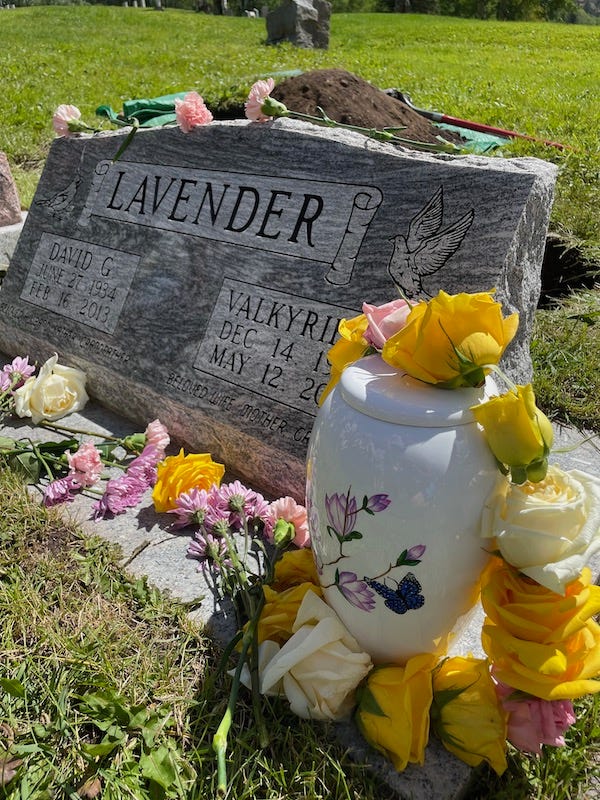
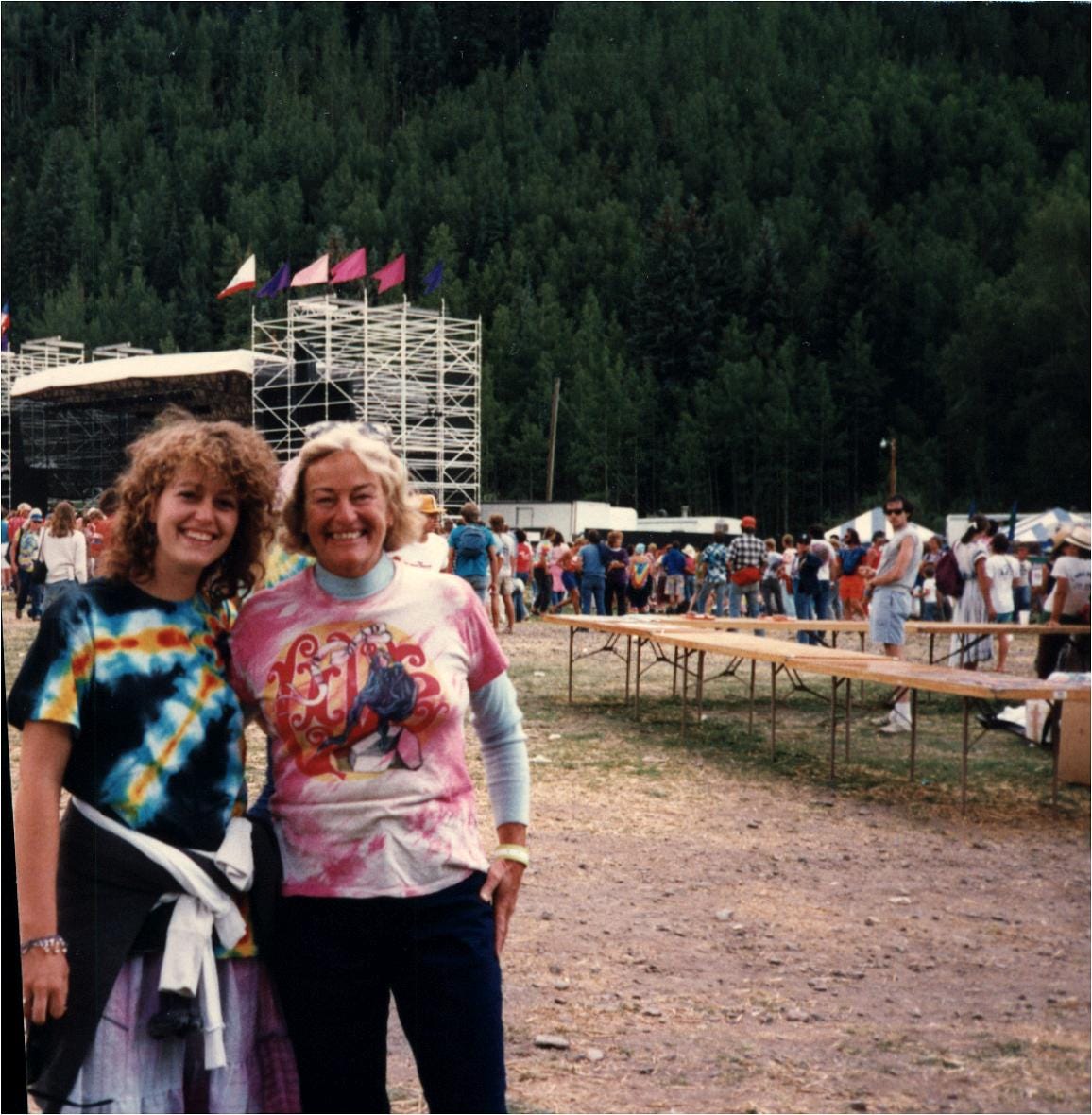
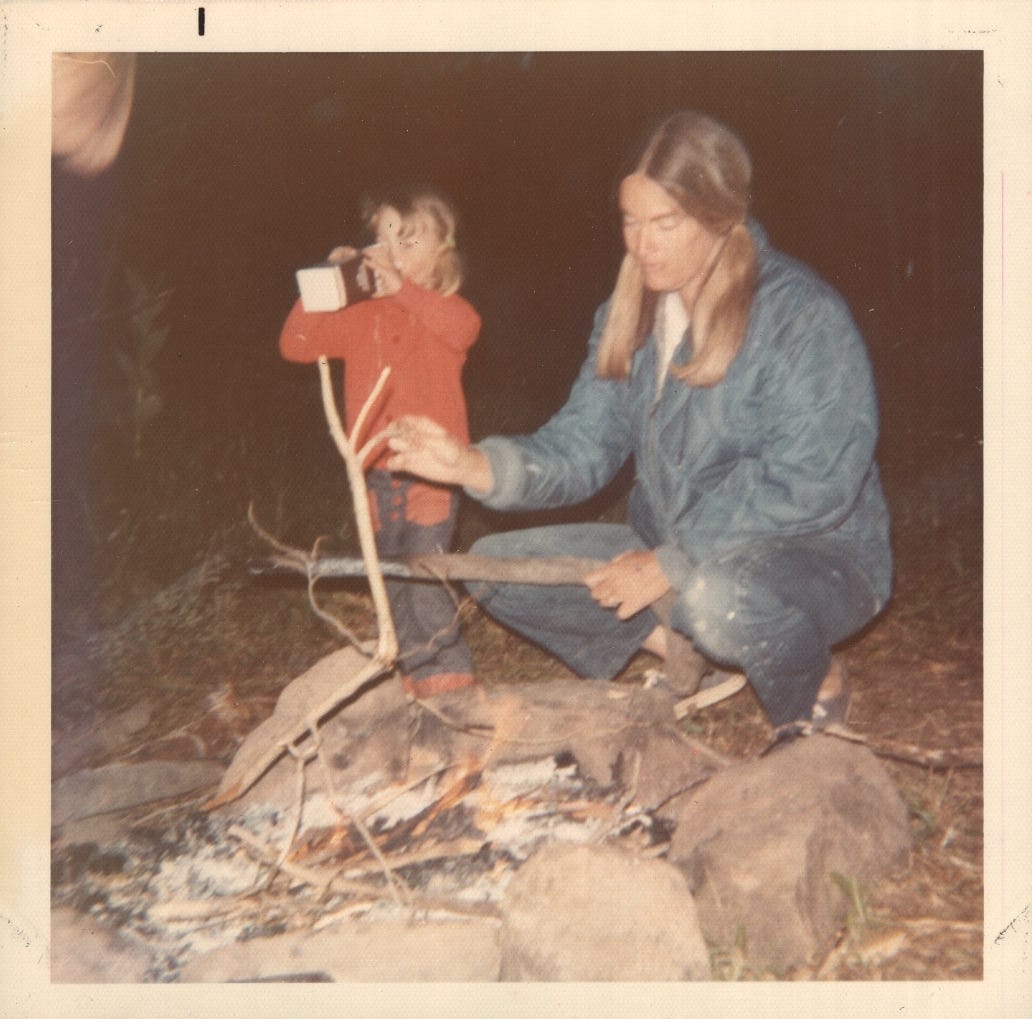
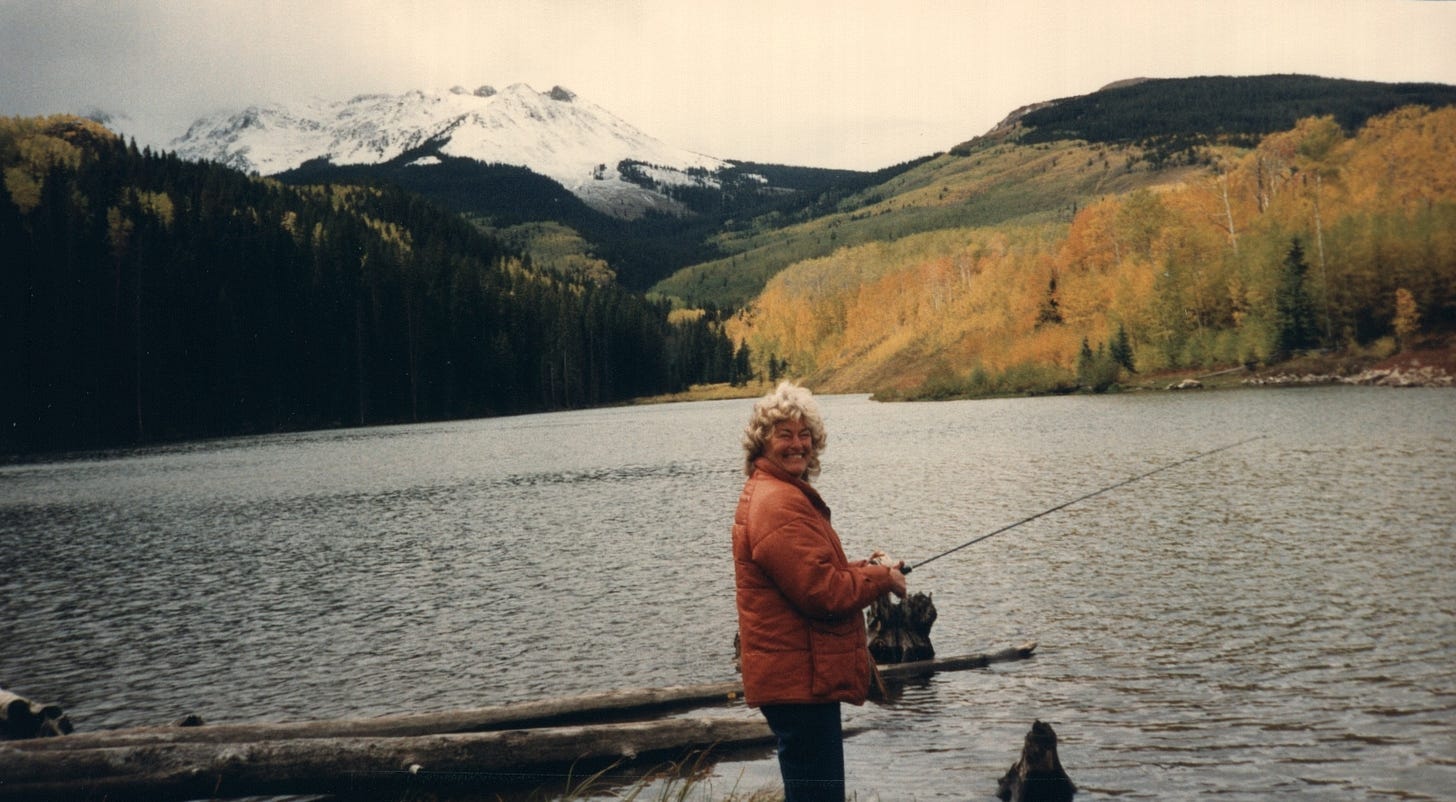
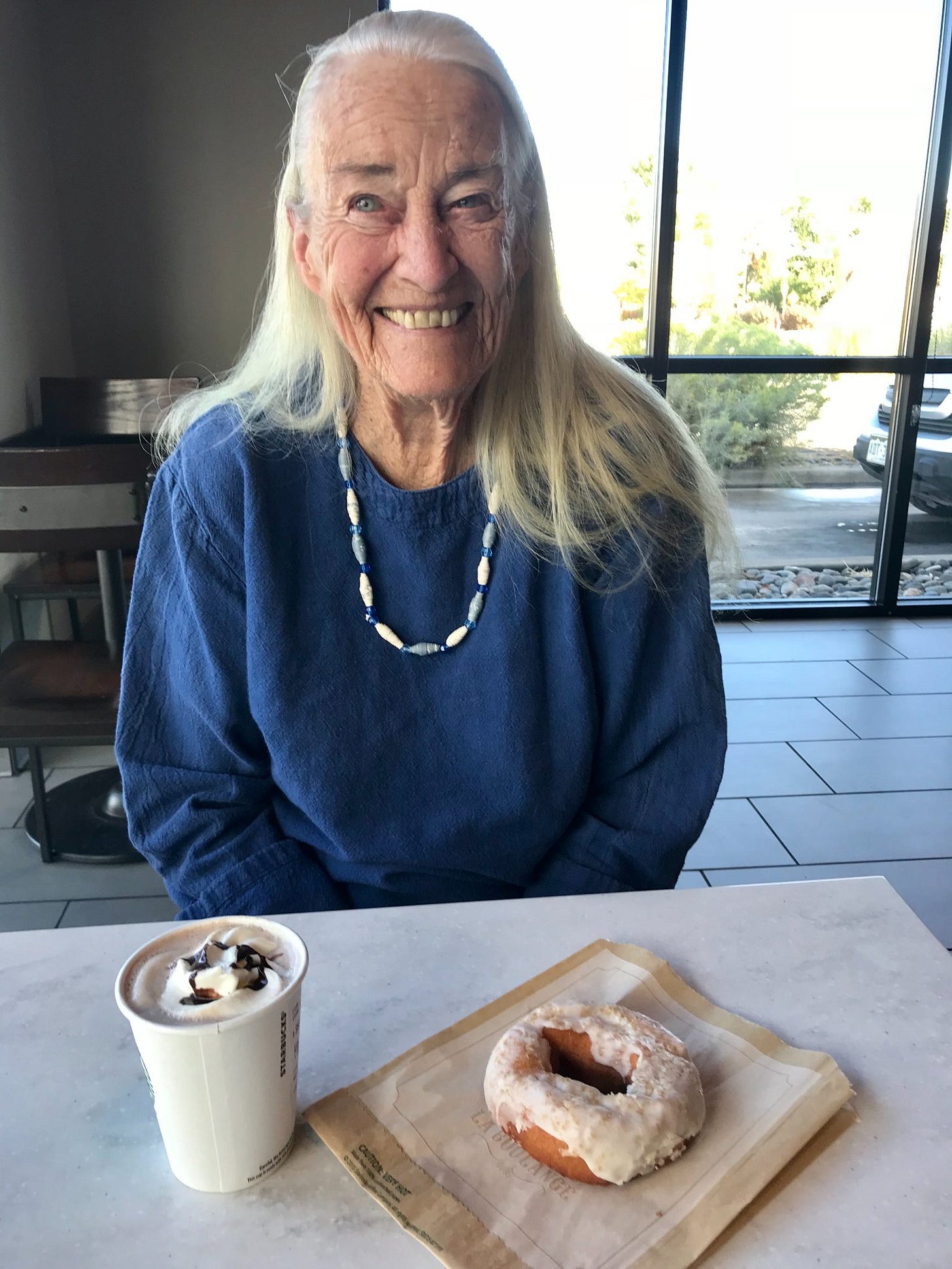
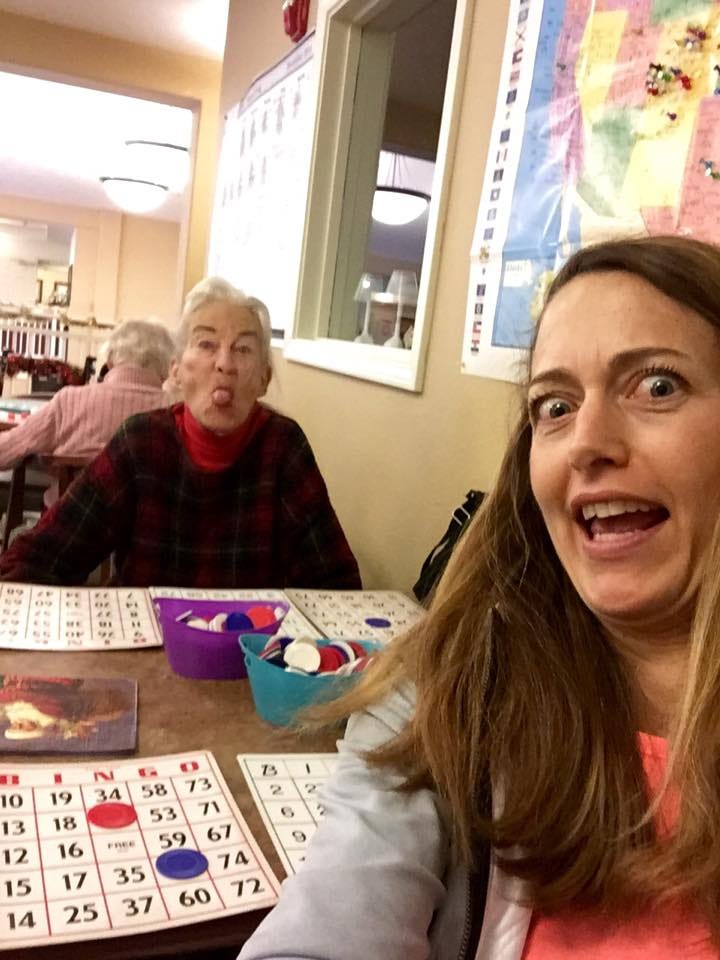

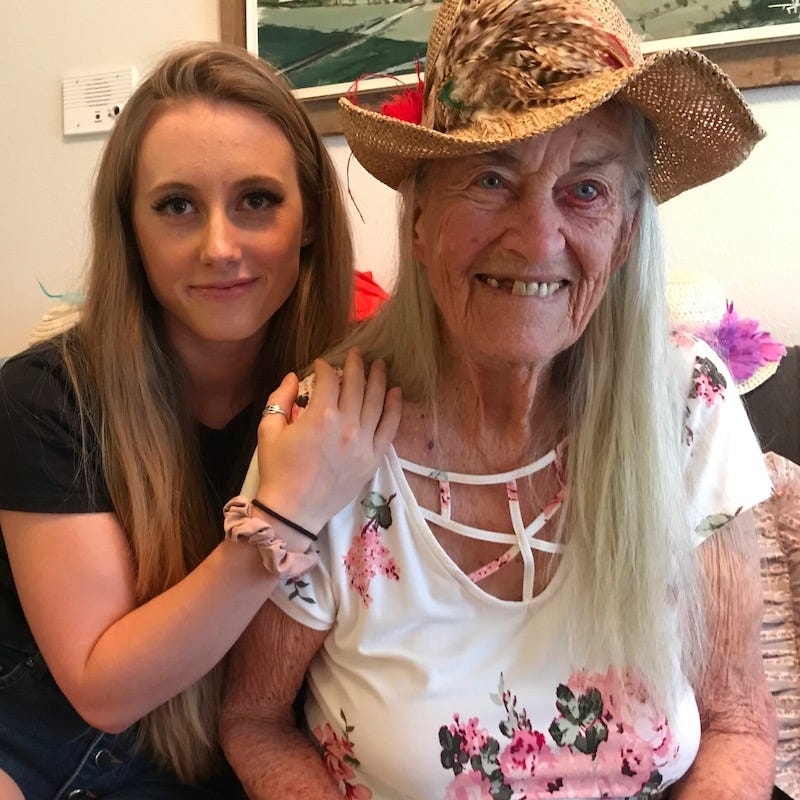

A really sweet tribute, Sarah (and great pictures!--that's Karen's t-shirt that mom's wearing at the Dead show). You are doing such a great job of embracing the best of your heritage. Keep it up!
What an incredible person your mother was and such a lovely tribute. The last picture ... oh man. Makes me feel like my own trajectory of carving my own path raising a family, feeling judgmental, then appreciating things in a new way with time & experience may be more common than I think. You write so beautifully and make everyone feel so at home & welcomed in your stories. You make everything feel so relatable. Calling my mom right now.